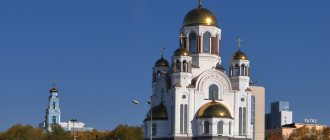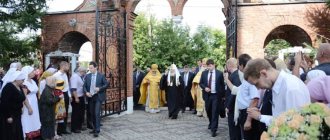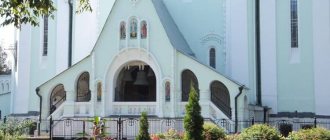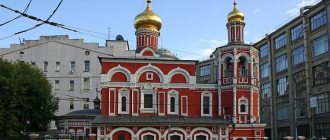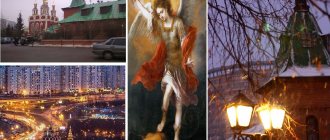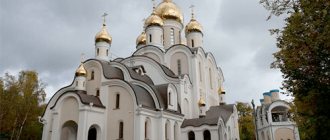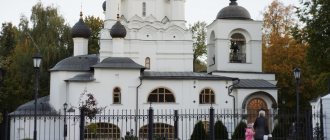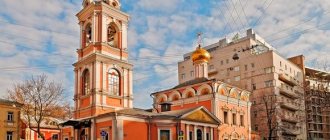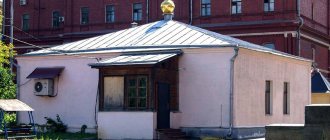The Church of the Holy Blessed Prince Alexander Nevsky appeared not so long ago. It operates under MGIMO, which contributes to the fame of the temple. Its ministers enthusiastically perform social service, communicate with young people and are active on the Internet. In this article we will learn more about the Alexander Nevsky Church on Lobachevsky.
| Temple of Alexander Nevsky | |
| A country | Russia |
| City | Moscow |
| Year of foundation | 2005 |
| Website | hramnevskogo.ru |
| Abbot | Archpriest Igor Fomin |
The idea to build a temple at MGIMO appeared in 1999
The possibility of constructing this building in Moscow at the State University of International Relations was first discussed in 1999. It is noteworthy that the initiative came from students and teachers.
But an idea is one thing, and its implementation is something completely different. It took a lot of time to sort out all the bureaucratic issues: getting permission, deciding on the composition of the clergy, etc. Only in 2005 did they begin to talk about the construction of the temple as something feasible. It was then decided that it would be dedicated to Prince Alexander Nevsky.
Why this particular saint? At least because there used to be a beautiful seventy-meter high Nevsky Cathedral in Moscow, which was demolished by the Soviet authorities in 1952. The current building cannot compare with it either in scale or splendor, but it pays tribute to the memory of the saint revered in Rus'.
Destroyed Alexander Nevsky Cathedral in Moscow
In 2007, priest Igor (Fomin) was appointed rector of the temple. Previously, he served in the Moscow Kazan Cathedral.
Archpriest Igor - rector of the Alexander Nevsky Church
Then there was a long break again, there were periods of coordination, planning, and weighing the pros and cons.
Another temple operated on this site since the 14th century; it was destroyed by the Bolsheviks
One of the decisive roles was played by the past of the land where construction was supposed to begin. The fact is that there was already a temple there before. It was erected in honor of St. Nicholas the Wonderworker a long time ago. Documents from the 14th century also mention this structure.
Of course, it has been rebuilt since then - most recently at the beginning of the 20th century. The building at that time could accommodate up to 300 parishioners at a time. It was erected from stone, as reported by the local newspaper.
But the revolution came, the Bolsheviks came to power, and in the 1930s the church was abandoned, and soon it was dismantled, so that not a trace remained of the previous building. Forty years later, a park area was erected on the holy place.
The construction of the Alexander Nevsky Temple is a correction of the mistakes of the past.
Therefore, the construction of a temple on this site is a correction of the mistakes of the past. If there has been a church here since the 14th century, then it is logical to return everything to its original position. This is true.
This argument became decisive for the local authorities, and the project moved forward.
How to get there
The temple is located at the address: Moscow, Lobachevsky Street, 23. There are two ways to get to your destination:
- On the metro, get off at the “Prospekt Vernadskogo” stop. Then transfer to one of the buses going along routes No. A793, A788, A42, 120;
- From the Yugo-Zapadnaya metro station, public transport follows routes No. A688, A785. Buses No. 688, 688k go from Kuntsevskaya station.
There are also direct routes to the cathedral - No. 793, 785, 688, 120 and 42.
Before construction, the social activities of the temple were agreed upon with the clergy.
In 2012, a temporary temple of St. Nicholas the Wonderworker was erected here. It differed from many other similar structures in its significant size. Services were held here, but Orthodox leaders did not stop there.
Temporary Church of St. Nicholas the Wonderworker
Building the temple required preparing the ground—not so much in the literal sense, but in the sense of planning how the temple would fit into the life of the university.
To achieve this, the clergy regularly met with students and teachers. They discussed where the activities of the clergy could be useful. During these conversations, several organizations were identified with which the temple would cooperate primarily:
- City Clinical Hospital No. 31.
- Dmitrovsky orphanage-boarding school for children with physical disabilities.
- Children's Infectious Diseases Clinical Hospital No. 6.
- Boarding house for labor veterans No. 29.
- Local secondary schools.
2013
starting this year there is a Sunday school at the church
Also, one of the primary tasks of the clergy of the Alexander Nevsky Church is caring for large families who find themselves in difficult life situations and need help.
It was understood that the range of tasks would gradually expand.
Shrines
The Temple of Alexander Nevsky on Prince Lake is rich in shrines: here are particles of the relics of many Christian saints: the apostles Peter, James Zebedee, Thomas, Bartholomew and other noble Russian princes: Oleg Bryansky, Vasily Yaroslavovich, Fyodor and Yaroslav of Murom, the righteous wives of Diveyevo: Elena, Mary, Martha and Pelageya, Saints Ignatius of the Caucasus (Brianchaninov), Peter and John, Metropolitans of Moscow, Luke of Crimea (Voino-Yasenetsky) and many other Russian martyrs and new martyrs.
The most famous are 2 images of the Blessed Virgin Mary - Tikhvin and Hodehydria of Korsun (Ephesus).
Korsun Icon of the Mother of God
According to legend, the Korsun icon was painted by the Evangelist Luke himself during the life of the Virgin Mary and was even approved by Her. According to one version, in 988 the image was brought through Korsun to Kyiv by the holy Equal-to-the-Apostles Prince Vladimir, who was baptized. According to another - in the 12th century. she ended up in Polotsk. Modern art historians believe that the image was lost and restored in the 14th century. one of the Pskov icon painters.
There is information that immediately after the enlightenment of the peoples of Rus' with the light of Christianity, Prince Vladimir ordered that the shrine be carried around the cities so that newly baptized people could see how the Mother of God should be depicted.
The Monk Euphrosyne, who lived about a hundred years later and came from a princely family, created a convent in Polotsk. At the request of the city residents, the Ephesian Icon of the Mother of God was kept there for about a year.
In this way, the noble prince Yaroslav blessed his son Alexander, who was later to become Nevsky, to marry the girl Paraskeva, whose father was the Prince of Polotsk. It was then, in 1239, that the icon ended up in the Toropets Cathedral, where the wedding of the young couple took place. The name of the icon - Ephesus - Korsun - Polotsk - Toropetsk - reflected the numerous movements of this shrine.
For more than seven centuries, the image was protected by Toropets from the invasion of Lithuanians and French, from hunger and epidemics, until after the October Revolution it was confiscated and transferred first to the local history museum, and then to the Russian Museum of St. Petersburg for seventy years.
In 2009, at the request of His Holiness Patriarch Kirill of Moscow and All Rus', the image was transferred to the temple for storage. Here one of the chapels was consecrated in his honor. To preserve the icon, a special icon case was built in which the required temperature and humidity were maintained.
Ephesus – Korsun – Polotsk – Toropetsk Icon of the Mother of God Hodehydria
Tikhvin Icon of the Virgin Mary
The Tikhvin image of the Mother of God was originally located in Jerusalem, from where Empress Eudokia transported it to Constantinople and built the Blachernae Temple especially in its honor.
In 1383, the image was revealed in the north of Rus', on Ladoga, 30 versts from the famous lake, where a temple was subsequently built, and then, under Ivan the Terrible, a monastery was created in which this miraculous icon, famous for its miracles of healing, resided.
In the 17th century Pskov craftsmen made a list from it, which was next to the miraculous icon for 5 years, which was subsequently located in the Anosina Borisoglebsk convent, and from where it was transferred to the Church of Alexander Nevsky.
Tikhvin Icon of the Virgin Mary
In three years, the Alexander Nevsky Temple was built and consecrated
In 2013, construction of the temple began. At that time, there was already a suitable project and experienced people capable of constructing the required building.
Quite quickly, behind an airy, transparent fence like a gossamer, a snow-white building with contrasting, dark roofs grew up. It rises in several tiers, tapering towards the top. Its facades are designed with restraint. There is something sublime in this brevity, reminiscent of the purity of heaven or the purity of a righteous soul.
At the very top of the temple there is a single dome in the shape of a candle flame. According to the Orthodox tradition, it symbolizes the one God, and its gilded surface recalls the primacy of the Creator.
After all, the color gold is always associated with royal power, and only the Lord can be called the only king of kings and our entire world.
Temple of Prince Alexander Nevsky
By the way, the “gold” was applied very painstakingly: it was nine thousand ceramic plates (ploughshare). The height of the building is 36 meters. The building will accommodate up to 500 pilgrims. There are the following outbuildings:
- belfry;
- gallery;
- refectory;
- baptismal church;
- buildings for economic purposes.
The finished temple was consecrated in 2016.
Cathedral style
In Russia, more than 40 buildings are dedicated to the name of the great commander Alexander Nevsky. For example, the church in Arkhangelsk is entirely made of logs. Cathedrals are also located in Tallinn and Sofia, Bulgaria. The majestic temple in Sofia is decorated with gilded domes.
The “200 Temples” project in the capital of Russia made it possible to create a building in the style of a new direction, and was erected for the 70th anniversary of the educational institution according to the design of A.A. Anisimov in the style of Pskov architecture. Archpriest Igor Fomin supported the idea of building a cathedral at the educational institution.
The cathedral is surrounded on three sides by a gallery, to the north-west there is a belfry, and to the south-east there is a clergy house. The architectural composition consists of the Nevsky Cathedral, the baptismal church, the house of parables and utility rooms.
Brothers and sisters in Christ. We run our own community on VKontakte https://vk.com/molitvuikonu called Prayers for Every Day, where we try to post Orthodox prayers and news. If you have your own VK page, subscribe to us.
The architectural style is created by multi-tiered coverings, white walls and a helmet-shaped dome with a golden cross. A distinctive feature of the structure is the main dome, decorated with nine thousand ceramic ploughshares reminiscent of a prince’s helmet. The facade and windows are decorated with carvings and mosaics. Entrance doors are wooden, the floor in the room is made of natural stone. The walls inside are covered with lime plaster with paintings and mosaics.
There is a plunge pool in the basement. The parable house has a refectory, a kitchen, offices, administrative and utility rooms, and a priest’s room.
Schedule of services
The temple is open daily from 8:00 to 20:00
Schedule of services on weekdays:
- 8:00 - repentance and morning service;
- 9:00 - liturgy, and then a memorial service;
- 17:00 - repentance;
- 18:00 - evening service.
Weekend worship schedules:
- 8:00 - repentance and morning service;
- 9:00 - liturgy, and then a memorial service;
- 16:00 - repentance, and after the liturgy to the Savior;
- 17:00 - evening service.
Particularly revered dates:
September 12 - transfer of the relics of Prince Alexander Nevsky;
December 6 is the day of remembrance of Saint Prince Alexander Nevsky.
On the official website of the temple you can read its history and find a lot of interesting information.
You can constantly find new information on the official website of the Alexander Nevsky Cathedral at MGIMO.
Official website of the Alexander Nevsky Temple
First of all, there is a lot of material about the temple itself:
- its history;
- photo gallery from various holidays and important events for the temple;
- news about ongoing events, lectures, matinees, concerts and meetings.
Interior of the Alexander Nevsky Temple
The site administration always keeps you informed about significant dates:
- anniversary of consecration;
- birthdays of people involved in the life of the temple;
- church holidays.
A section on church sacraments and rituals is currently being written. In the future there will be separate articles on confirmation, baptism, ordination, etc.
Of the already existing sections, the pages on social service deserve special attention, where they talk in detail about such organizations as:
- temperance society;
- house of hard work "Noah";
- center for work with the deaf and hard of hearing.
Believers will also be interested in reading personal stories about the spiritual insights of Orthodox Christians like them.
By leaving a comment, you accept the user agreement

